Yak lace
Yak lace refers to a coarse bobbin lace typically made from wool.[1] It was mainly made in Oxfordshire, Buckinghamshire and Northamptonshire in imitation of Maltese and Greek laces.[2][3] While the name suggests the lace is made using yak hair, it can be made of any wool or worsted yarn.[1][2]
Whilst woolen laces had been made from the 17th century onwards, it was not until the mid 19th century that "yak lace" became popular.[2] Despite the difficulty of working with naturally elastic woolen yarn which meant that the lace instantly shrank to two thirds of its size once unpinned from the pillow, it was inexpensive, quick and easy to make and became popular and widely used.[2] Yak lace could be produced in various weights, ranging from lightweight trimmings for children's dresses and underwear, to heavier, upholstery-weight lace suitable for curtains.[2] Black yak lace was also widely used for mourning dress.[1][2] The popularity of woolen lace was boosted by the nineteenth century hygienist Gustav Jäger's promotion of wool fabrics.[2]
References
- 1 2 3 It was a guipure style of lace. Definition of yak lace at the Embroiderer's Guild website. Accessed 8 June 2012
- 1 2 3 4 5 6 7 Makovicky, Dr. Nicolette, Beds Maltese and 'Yak' lace, The Pitt Rivers Museum, Oxford. Accessed 8 June 2012
- ↑ Jackson, Emily (1971). A history of hand-made lace. Tower Books.
